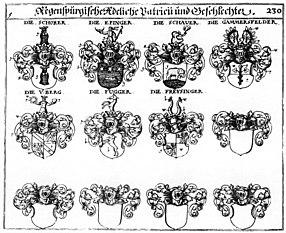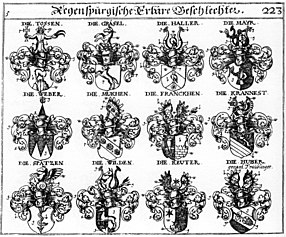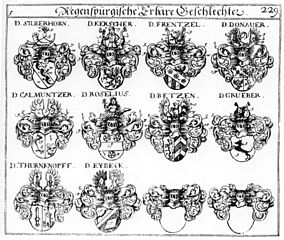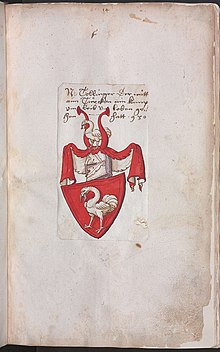Regensburg patrician families
The patriciate of the imperial city of Regensburg provided the urban power center of the Free City of Regensburg , the Inner or Secret Council , especially in the 13th to 16th centuries . In Regensburg, the birth class principle of the patriciate was important, but not as important as in Augsburg or Nuremberg . An ascent to the patriciate through economic success was basically possible, even if it was of course only possible for individuals and was to be secured by marrying old families (conubium). Due to the overlapping of royal, ducal and episcopal claims to power in the city of Regensburg, the situation was always complex. The genealogical towers that have survived to this day show the high status of the wealthy patrician families in Regensburg.
history
Regensburg experienced a political and cultural boom as early as the 11th century. Three city lords competed for control of Regensburg: the Bavarian duke , the bishop of Regensburg and the king or emperor . The rule of Regensburg experienced a marriage especially under Emperor Heinrich II , whose tutor was Bishop Wolfgang von Regensburg . In addition to the three city lords, however, the wealthy citizens of the city now also stood up. In 1207 and 1230, King Philip of Swabia and Emperor Friedrich II granted the city extensive privileges, which subsequently enabled it to become a Free City . Was there 1232 with the so-called. "Ravenna Diploma" was another setback in the struggle for independence, the Regensburg citizens achieved on November 10, 1245, when Emperor Friedrich II gave the city the right of self-government with the "Edict of Pavia" with the privilege of "a mayor and council to put "confirmed. The lucrative long-distance trade made the city a hub. In the city, which had around 20,000 inhabitants, a rich bourgeoisie of around 2,000 people emerged who played the main political role. The heads of 50 - 60 of these families formed the patriciate , which at that time made up the city government, the Inner or Secret Council .
The patrician families began a brisk building activity. It emerged powerful patrician house castles of stone with gender towers as status symbols, of which the Golden tower is preserved in its original height. As in many southern German cities, the rule of the patrician families in the city was not without disputes. In the Lichtenberger Schied in 1281 knights, minters and brewers on the one hand and citizens and merchants of the town on the other. It was confirmed by the arbitration that the Regensburg Hansgraf was essentially responsible for the concerns of the merchants on their trade trips outside the city. In his work “Council Constitution and Patriciate in Regensburg until 1400”, Morré put forward the thesis that it was essentially about disputes between the administrative and the commercial patriciate. The clashes within the city continued to escalate. The patrician Friedrich Auer , supported by Emperor Ludwig IV , had initially allied himself with the guilds and became mayor in 1331. There he developed a dictatorial regime and was overthrown again in 1334. The city of Regensburg, unsettled and weakened by the Auer uprising, was surprisingly threatened in 1337 by an army of Emperor Ludwig IV , who made a new, but ultimately unsuccessful, attempt to bring the city of Regensburg back to the Duchy of Bavaria . The support of the imperial side cost u. a. the Regensburg patrician Konrad Frumold .
At the beginning of the 14th century there were signs of an economic downturn in Regensburg, caused by the shift in trade routes in the East and East trade. This benefited other cities such as Augsburg , Vienna and Nuremberg , which recorded economic growth and - unlike Regensburg - increasing population numbers. The economic decline of Regensburg continued in the 15th century and ultimately led to the city's bankruptcy. The crash was initiated by the Hussite Wars that began in 1419 . There was an outflow of capital and the departure of wealthy families from Regensburg, because the city, which lived only from long-distance and transit trade, had failed to promote handicrafts and the production of consumer goods in the 14th century.
The Habsburg Emperor Friedrich III reacted to the submission of the city of Regensburg to Bavarian rule in August 1486 . and his son, who was crowned king and co-ruling since 1486, later Emperor Maximilian I , to take legal action against the Wittelsbach rivals from the Reich . In 1496 the city of Regensburg lost its status as a free city and became an imperial city under the supervision of imperial commissioners, whose powers were laid down in regimental regulations and protection treaties. A 30-year phase of social unrest began in the city, which in 1519 also led to the expulsion of the Regensburg Jews. The internal unrest in the city escalated in 1511 when Emperor Maximilian I appointed the Franconian nobleman Thomas Fuchs von Wallburg as the new Imperial Governor for Regensburg. The majority in the city council resisted the appeal for 2 years. A power struggle began between the emperor and the city council, in the course of which the loyal councilor Konrad Liskircher was kidnapped, imprisoned, tortured and hanged by the mob in 1513. After sending some imperial commissions, the appointment of Thomas Fuchs von Wallburg as the new imperial governor was finally enforced. Then the party members of the Bavarian duke were settled. As ringleader , the cathedral builder Wolfgang Roritzer was executed together with more than 100 followers . The Emperor Maximilian I imposed a new city constitution on the city in 1514, the so-called "regimental order", which formally remained in force until 1803. Power lay in the hands of the members of the Inner Council with 16 councilors, one of which was chamberlain (mayor) for a year and from 1523 for a quarter. Due to the decline in long-distance trade and the expulsion of the long-established patrician families by the emperor, the inner councils were recruited from the new economic ranks of the iron and transport traders. The birth class principle of the patriciate no longer played a major role in the occupation of the inner or secret council of the city. The patriciate of the city remained as an urban upper class until the end of the imperial city in 1802/3.
Coat of arms in the sieve maker
From Siebmacher's coat of arms 1701/5:
- Rainforest (Adeliche) Patricii
- Hereditary genders with rain
Note: In the class structure of the imperial city of Regensburg, a distinction was made between the first class, the patriciate (= "Adeliche Patricii"), and the second class, referred to as respectability, in the division of the ruling families.
Familys

Incomplete compilation according to Morré, Siebmacher, Hylmair and Fürnrohr
- Adler, a noble patrician family according to Siebmacher's coat of arms 1701/5, from Innsbruck, provided a total of 6 councilors
- Aichinger v. Aichstamb, noble patrician family according to Siebmacher's coat of arms book 1701/5
- Altdorffer (also Altdorfer), noble patrician family according to Siebmacher's coat of arms book 1701/5
- Albrecht Altdorfer († 1538): painter, engraver and builder of the Renaissance, since 1526 in the Inner Council.
- Altschmid, patrician family according to Siebmacher's coat of arms 1701/5
- Aman (also Ammann), patrician family according to Siebmacher's coat of arms book 1701/5
- Auer or Auer zu Brennberg , family originally episcopal ministerial , most important patrician family of Regensburg of the 13th and 14th centuries. The Auer died out in 1483.
- Friedrich Auer († 1356): mayor and patrician, 1331 mayor of Regensburg (so-called Auer uprising). In 1334 expelled from the city for his acts of violence. Retired to his castle in Brennberg , from where he led violent feuds against the Regensburg residents. 1343 reconciliation with the city, became a citizen again for six years.
- Berg (also v. Bergh, Bergen), noble patrician family according to Siebmacher's coat of arms 1701/5
- Beutler, noble patrician family according to Siebmacher's coat of arms 1701/5
- Birgel (also Byrbel, Pirckel), patrician family according to Siebmacher's coat of arms 1701/5
- Deueme (also Deuem), noble patrician family according to Siebmacher's coat of arms 1701/5
- Diemer, patrician family after Hylmair
- Dimpfel, patrician family according to Siebmacher's coat of arms 1701/5
- Dollinger (also Tollinger), noble patrician family according to Siebmacher's coat of arms 1701/5, known from the Dollinger saga
- Drescher, noble patrician family according to Siebmacher's coat of arms book 1701/5
- Dürnstetter, patrician family of the 14th century
- Konrad Dürnstetter († around 1365): patrician, Hansgraf and chamberlain
- Eckhenthaler, noble patrician family according to Siebmacher's coat of arms book 1701/5
- Eder, noble patrician family according to Siebmacher's coat of arms 1701/5
- Epinger (also Eppinger), noble patrician family according to Siebmacher's coat of arms 1701/5, Regensburg patrician family of the 16th and 17th centuries
- Fugger vom Reh , an important noble patrician family from Augsburg . According to Siebmacher's Wappenbuch 1701/5
- Flat, noble patrician family according to Siebmacher's coat of arms 1701/5
- Flucken (also Fluck), noble patrician family according to Siebmacher's coat of arms 1701/5
- Freysinger, noble patrician family according to Siebmacher's coat of arms 1701/5
- Frumold (also Frumolt), patrician family of the 14th century
- Konrad Frumold († 1339): Regensburg patrician, had an underground passage dug under the city wall to make it easier for Emperor Ludwig the Bavarian to penetrate the city. When it was said that if the perpetrator surrendered he would only have to pay £ 200 pfennigs, he revealed the secret but was arrested, tortured and executed.
- Fuchs, patrician family after Hylmair, provided 5 councilors.
- Gammersfelder, noble patrician family according to Siebmacher's coat of arms book 1701/5
- Gebhardt, patrician family according to Siebmacher's coat of arms 1701/5
- Geyer, noble patrician family according to Siebmacher's coat of arms book 1701/5
- Gravenreuther (also Grafenreuther), patrician family of the 14th century
- Konrad Gravenreuther († 1381): patrician in Regensburg
- Graner, patrician family of the 14th century
- Otto Graner († 1383): Regensburg patrician, in his day by far the most highly taxed wine merchant in Regensburg.
- Gryenewald (also Grüenenwald), patrician family according to Siebmacher's coat of arms 1701/5
- Gumpelshaimer (also Gumpelzhaimer), patrician family according to Siebmacher's coat of arms 1701/5, came to Regensburg in the 17th century, provided a total of 6 councilors
- Christian Gottlieb Gumpelzhaimer († 1841), historian and legation counselor
- Gumprecht, patrician family and partisans of the Auer family, Gumprecht's house has been preserved
- Leopold Gumprecht the Elder († 1327/28): patrician in Regensburg
- Ortlieb Gumprecht († around 1340): 1322/23 mayor of Regensburg, expelled from the city by the opposing party around Berthold von Ergoldsbach in 1326 with his Dietrich von Au
- Groszhedel (also Großschedel), noble patrician family according to Siebmacher's coat of arms 1701/5
- Franz von Großschedel : got his imperial nobility confirmed in 1566
- Hertzmanseder (also Hetzmanseder), noble patrician family according to Siebmacher's coat of arms 1701/5
- Häberl (also Haeberl, Haberl), noble patrician family according to Siebmacher's coat of arms 1701/5
- Haid, patrician family of the 14th century
- Gumprecht an der Haid († 1325): Regensburg patrician, his three daughters, two of whom married into the Auer family, paid their debts with his fortune.
- Haman, patrician family according to Siebmacher's Wappenbuch 1701/5, "Are one name (with Hamman), but two gender and shield"
- Hamman, patrician family according to Siebmacher's coat of arms 1701/5
- Harrer, patrician family after Hylmair
- Huber (also Hueber), noble patrician family according to Siebmacher's coat of arms 1701/5
- Holstain (also Holsteiner), noble patrician family according to Siebmacher's coat of arms book 1701/5
- Humer, noble patrician family according to Siebmacher's coat of arms 1701/5
- Ingolstetter, patrician family from the 12th to 14th centuries. The so-called Ingolstetter House (12th century) has been part of the tobacco factory Gebrüder Bernard since 1812
- Lukas Ingolstetter († 1444): Regensburg patrician
- Khol, noble patrician family according to Siebmacher's coat of arms book 1701/5
- Khurz (also Kurz, Khurtz), noble patrician family according to Siebmacher's coat of arms 1701/5
- Koeller (also Köler, Köller), noble patrician family according to Siebmacher's coat of arms 1701/5 * Kastenmayer (also Kastenmayr), patrician family from the 13th to 15th centuries, whose patrician castle with its massive four-storey tower has been preserved
- Kolb, noble patrician family according to Siebmacher's coat of arms 1701/5
- Kramer (also Cramer), noble patrician family according to Siebmacher's coat of arms 1701/5
- Circles (also Kraissen), patrician family according to Siebmacher's coat of arms book 1701/5
- Leopold, patrician family according to Siebmacher's coat of arms 1701/5
-
Lerchenfelder (also von Lerchenfeldt), noble patrician family according to Siebmacher's coat of arms book 1701/5, as Lerchenfelder zu Prennberg on April 26, 1587 they received a coat of arms improvement and imperial nobility confirmation with the predicate of Lerchenfeldt. The coat of arms of the extinct noble family von Prennberg (and also the Auer), in silver three green flaming mountains open at the bottom, was added to the family coat of arms. Branches of the family still exist today.
- Hugo Lerchenfeld († after 1216): citizen and canon of Regensburg, proven as the first of the family in Regensburg
- Lincken (also Linck), patrician family according to Siebmacher's coat of arms book 1701/5
- Marchtaler, patrician family according to Siebmacher's coat of arms 1701/5
- Memminger (also Mämminger), noble patrician family according to Siebmacher's coat of arms 1701/5, came from Deggendorf to Regensburg in the middle of the 16th century , provided a total of 7 internal councilors.
- Meusinger, noble patrician family according to Siebmacher's coat of arms 1701/5
- Miller, patrician family after Hylmair
- Naumeyr (also Nalmeyr), noble patrician family according to Siebmacher's coat of arms 1701/5
- Neiss (also Neyssen), noble patrician family according to Siebmacher's coat of arms 1701/5
- Perger, patrician family after Hylmair, not related to the Berg family
- Peuchel (also Peychel), noble patrician family according to Siebmacher's coat of arms 1701/5
- Pfaffenreuter, patrician family according to Siebmacher's coat of arms 1701/5
- Portner , noble patrician family according to Siebmacher's coat of arms 1701/5
- In 1317 a Heinrich I. Portner appears in the Regensburg council lists in the Hanseatic Committee. Up to 1500 another eight Portner were known as councilors, chambermen and as "45s" (member of the 45-person external council). As economic conditions changed, Portners became administrators and lawyers in the centuries that followed. Seven Portners are named as Kammerer between 1514 and 1670 . In 1670 Andreas Portner was the last of the Regensburg Portner to leave the city.
- Prasch, patrician family according to Siebmacher's coat of arms book 1701/5
- Rich, important patrician family of the 14th century
- Ruger Reich († 1352): Regensburg patrician, financier and sponsor of Emperor Ludwig of Bavaria
- Gottfried Reich († 1357): Regensburg patrician, in his debt were numerous crowned heads, some of whom could not redeem the pledges.
- Matthäus Reich († 1367): Regensburg patrician, murdered the canon Konrad von Braunau. This sparked controversy between the bishop and the city council. In his will, he told his wife Agnes that she would largely disinherit her if she married again after his death. His four sons Matthäus, Hans, Wolfgang and Jörg sold numerous houses after his death.
- Reitmohr (also Reitmohren), noble patrician family according to Siebmacher's coat of arms 1701/5
- Roden (also Rodt, Roten, Roth, Rothen), noble patrician family according to Siebmacher's coat of arms 1701/5
- Rueland, patrician family after Hylmair
- Runtinger, an important patrician family in the late 14th century. The Runtingerhaus is one of the oldest and best preserved patrician houses in Regensburg
- Matthäus Runtinger († 1407): Regensburg patrician. Richest long-distance trader in Regensburg at his time, ⚭ with Margarethe, née Grafenreuther
- Schauer, noble patrician family after Hylmair
- Schiltel, patrician family according to Siebmacher's coat of arms 1701/5
- Schorer, noble patrician family according to Siebmacher's coat of arms 1701/5
- Schwebel, noble patrician family according to Siebmacher's coat of arms book 1701/5
- Schwoller, noble patrician family after Hylmair
- Sponfelder, patrician family according to Siebmacher's coat of arms book 1701/5
- Thenn, noble patrician family according to Siebmacher's coat of arms 1701/5
- Thundorfer, noble patrician family from the 12th to 14th centuries, builder of the Goliath House
- Leo Thundorfer († 1277): 30th Bishop of Regensburg
- Widemann (also Widenmänner, Widmann), patrician family according to Siebmacher's coat of arms 1701/5
- Wild, patrician family, around 1600 provided nine councilors, with the Plato-Wild line (progenitor Georg Gottlieb Plato-Wild ) together even 11 inner councilors, from 1604 to 1800
- Wolff (also Wolffen), patrician family according to Siebmacher's coat of arms book 1701/5
- Woller, patrician family, extinct in 1377.
- Ulrich Woller († 1375): Regensburg patrician, his brother Otto Woller († 1377) was mayor in Regensburg. With him, the Woller family died out.
- Zant (also Zandt), important patrician family in the 13th and 14th centuries. Today's St. Katharina Hospital Church was built towards the end of the 13th century as an extension of the mausoleum of the Regensburg patrician family Zant.
- Heinrich Zant († 1313): patrician, founder of the former infirmary and leper house in the city park of Regensburg . The Zant Cross still commemorates his murder today.
- Albrecht Zant the Elder († 1359): Mayor and patrician, took part in the Auer uprising. His brothers Stephan († around 1371) and Heinrich also held the office of mayor.
- Albrecht Zant the Younger († after 1366): mayor and patrician, last mayor from the family of Zant, who held the office since 1290. Quarrel with the father. In 1359 the mayor, the council and the municipality decided that the Zant “should never be a judge in our statute”.
literature
- Tobias Beck: Emperor and imperial city at the beginning of the early modern period. The Reich Main Team in the Regensburg Regimental Orders 1492–1555 , Regensburger Studien 18, 2011, ISBN 978-3-935052-89-4 ( table of contents )
- Wiltrud Eikenberg: The trading house of the Runtinger in Regensburg. A mirror of southern German legal, commercial and economic life in the late 14th century . Vandenhoeck & Ruprecht, Göttingen 1976, ISBN 3-525-35352-9 , (= publications of the Max Planck Institute for History , 43).
- Berta Ritscher: The development of the Regensburg council constitution in the social and economic structure of the period from 1245–1429 , dissertation, September 1974. ( Online )
- Peter Morsbach: The Auer uprising. In: Peter Brielmaier, Uwe Moosburger (Ed. Peter Morsbach): Regensburg. Metropolis in the Middle Ages. Friedrich Pustet, Regensburg 2007, ISBN 978-3-7917-2055-5
- Fritz Morré: Council constitution and patriciate in Regensburg until 1400. In: Negotiations of the Historical Association for Regensburg and Upper Palatinate 85 (1935). ( Online )
Individual evidence
- ^ Berta Ritscher: The development of the Regensburg council constitution in the social and economic structure of the period from 1245-1429 , pp. 105-106.
- ↑ King Philip of Swabia, city charter privilege , 1207, digitized image in the photo archive of older original documents of the Philipps University of Marburg , printed: Mon. Boica 29.1 p. 532 No. 586.
- ^ Matthias Freitag: A short history of the city of Regensburg . Pustet, Regensburg 2016, ISBN 978-3-7917-2823-0 .
- ^ A b Fritz Morré: Council constitution and patriciate in Regensburg until 1400 , in: Negotiations of the Historical Association for Regensburg and Upper Palatinate 85 (1935), p. 102 ff.
- ↑ Peter Morsbach, Martin Weindl: The Auer uprising. and The city war of 1388. in: Peter Brielmaier, Uwe Moosburger (Ed. Peter Morsbach): Regensburg. Metropolis in the Middle Ages. Friedrich Pustet, Regensburg 2007, ISBN 978-3-7917-2055-5 , pp. 218-219, 222-225.
- ^ A b Guido Hable: History of Regensburg. An overview by subject area . MZ-Verlag (1970) pp. 80-81.
- ↑ Peter Briel Meier, Uwe Moosburger: Regensburg. Metropolis in the Middle Ages. Edited by Peter Morsbach. Friedrich Pustet, Regensburg 2007, ISBN 978-3-7917-2055-5 , p. 244 f.
- ↑ Birgit Angerer: Regensburg's economic decline. In: Peter Brielmeier, Uwe Moosburger: Regensburg. Metropolis in the Middle Ages. Edited by Peter Morsbach. Friedrich Pustet, Regensburg 2007, ISBN 978-3-7917-2055-5 , pp. 246-247.
- ^ Karl Bauer: Regensburg. 2014, ISBN 978-3-86646-300-4 , pp. 203-204.
- ^ Karl Bauer: Regensburg. 2014, ISBN 978-3-86646-300-4 , p. 123.
- ^ Werner Fees-Buchecker: Council and political leadership of the imperial city of Regensburg 1485-1650. Studies on the constitutional and social history of Regensburg in the early modern period , Diss., Munich 1998, p. 210.
- ↑ Siebmacher's Wappenbuch, tables of the 9th edition 1701 and the 10th edition 1705.
- ↑ Hans Hylmair's (Goldschmids) Regensburgisches Wappenbuch - BSB Cgm 2015
- ^ Walter Fürnrohr: The patriciate of the Free Imperial City of Regensburg at the time of the Perpetual Reichstag in: VHVO 93 (1952), pp. 153-308.
- ↑ Monumenta Boica, 1956, p. 53 f.














